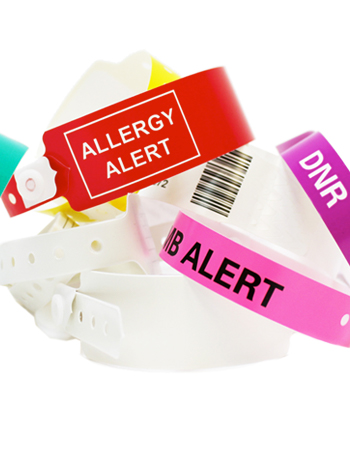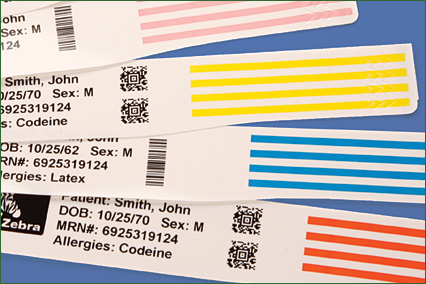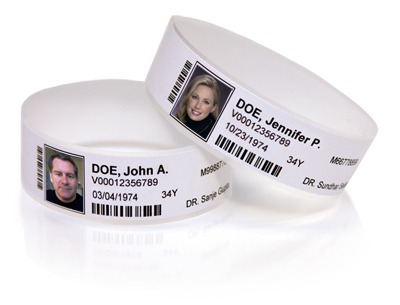How Patient Identification Band Improves the Overall Patient Experience in Medical Facilities
Wiki Article
Enhancing Safety: The Relevance of Person Recognition Bands in Healthcare
In the world of medical care, the effectiveness of individual recognition bands can not be overstated, as they work as a basic safeguard versus misidentification and subsequent mistakes. These bands, commonly overlooked, consist of critical info that is essential for guaranteeing individual safety and security and optimal therapy end results. The implementation of reliable recognition methods poses several challenges that healthcare companies need to navigate. As we check out the complex duty of these bands, it comes to be noticeable that their relevance expands past plain identification, questioning concerning best practices and future advancements in person safety and security.Introduction of Client Identification Bands
Patient recognition bands play a critical function in guaranteeing the safety and precision of client treatment in health care setups. These bands, normally worn on the wrist or ankle, function as an important tool for validating client identity, therefore lessening the risk of mistakes in therapy, medicine administration, and other health care procedures. Made from sturdy materials, individual identification bands frequently consist of vital details such as the patient's name, day of birth, medical document number, and barcodes or QR codes for scanning.The application of person identification bands is crucial in various medical care environments, including hospitals, outpatient facilities, and lasting treatment institutions. They add to an organized method in individual administration, making it possible for healthcare professionals to swiftly and properly identify individuals, especially in high-pressure circumstances where quick decision-making is essential.
In addition, the usage of these bands is aligned with regulatory standards aimed at boosting patient safety - Patient Identification Band. By guaranteeing that each person's information is conveniently proven and conveniently obtainable, doctor can maintain a high standard of treatment, decrease the incidence of unfavorable events, and promote a culture of security within healthcare organizations
Benefits of Accurate Identification
Accurate recognition is basic to improving client safety and care quality in health care settings. It acts as the first line of protection against errors that might result in adverse patient end results. By ensuring that each person is properly determined through reliable methods, such as individual identification bands, healthcare providers can dramatically lessen the risk of misidentification, which can bring about improper treatments, medication errors, and even medical mix-ups.Additionally, accurate person identification promotes efficient interaction among medical care groups. When all employee can consistently identify people, they can share vital info much more efficiently, causing better sychronisation of care. This is especially important in emergency situation scenarios where timely treatments are essential.
In addition, accurate recognition sustains compliance with governing requirements, consequently decreasing the threat of legal consequences for medical care centers. It fosters depend on between clients and medical care service providers, as individuals really feel more protected understanding that their identities are being protected.

Typical Challenges Encountered
Guaranteeing effective person identification in health care setups provides an array of challenges that can compromise safety and security and care top quality. Clients might arrive in a state of complication or distress, making exact identification tough.An additional difficulty is the dependence on human consider identification treatments. Medical care professionals might accidentally misinterpret or overlook identification procedures, particularly in high-stress atmospheres such as emergency situation divisions. This can bring about errors, consisting of the management of incorrect treatments or drugs.
Technical issues also present obstacles. Digital health record (EHR) systems are developed to improve client identification, system interruptions or individual errors can interfere with the procedure. The physical style of person ID bands can lead to readability concerns, particularly in situations where bands are damaged or covered.
Last but not least, irregular training amongst staff relating to identification protocols can result in gaps in understanding and practice. Addressing these challenges is crucial for enhancing person safety and security and making certain that recognition bands serve their designated purpose properly.
Best Practices for Implementation
To successfully implement person identification bands in healthcare setups, organizations must take on a multifaceted strategy that focuses on innovation, training, and standardization integration. Standardization includes developing clear methods for the style, application, and use of recognition bands throughout all departments. This ensures uniformity and lessens the risk of mistakes connected to variances in band kinds or labeling methods.

Training is important for all healthcare personnel to ensure they comprehend the relevance of precise person recognition, how to properly apply and review identification bands, and the treatments to comply with in situation of discrepancies. Routine workshops and refresher training courses can enhance this understanding and promote a culture of safety.
Technology assimilation plays a pivotal duty in enhancing the efficiency of person recognition bands. Using barcode scanning or RFID modern technology can simplify the recognition procedure, enabling real-time verification of patient identifications. Furthermore, digital health record systems must be set up to include signals for inequalities between the identification band and patient data.
Future Trends in Individual Security
As healthcare continues to advance, the emphasis on person security is likely to intensify, driven by innovations in modern technology and a better understanding of systemic dangers. Emerging trends suggest a shift in the direction of even more integrated systems that take advantage of information analytics, synthetic intelligence, and equipment discovering to enhance person recognition processes. These innovations can aid recognize possible security concerns before they intensify, thereby reducing mistakes related to misidentification.Furthermore, the application of blockchain discover this innovation might change how patient information is safely shared among healthcare carriers, ensuring that identification bands are up-to-date and regularly exact. This will not only boost person security however also help with seamless communication across multidisciplinary teams.

On top of that, the growing emphasis on personalized medication is anticipated to affect person security procedures. By integrating demographic and genetic details right into identification systems, health care specialists can customize therapies extra efficiently, minimizing the threats of negative responses because of misidentification.
Conclusion
Finally, person recognition bands function as an important component in enhancing safety within medical care environments. By assisting in exact individual recognition, these bands dramatically decrease the danger of mistakes connected with misidentification, inappropriate therapies, and medicine management. In spite of obstacles in application, adherence to finest practices and the integration of emerging technologies can further improve their effectiveness. Eventually, the ongoing emphasis on robust recognition protocols will certainly add to better client outcomes and overall security in healthcare settings.In the realm of healthcare, the efficacy of individual Find Out More identification bands can not be overemphasized, as they offer as a fundamental secure versus misidentification and succeeding errors.Person identification bands play a vital function in guaranteeing the security and accuracy of person care in healthcare setups. Made from long lasting products, patient recognition bands often consist of essential information such as the individual's name, date of birth, medical document number, and barcodes or QR codes for scanning.
By guaranteeing that each individual is appropriately identified with dependable ways, such as person identification bands, health care providers can substantially decrease the risk check out here of misidentification, which can lead to unacceptable treatments, medication errors, and even surgical mix-ups.
In conclusion, person identification bands offer as a vital component in boosting safety and security within medical care environments. Patient Identification Band.
Report this wiki page